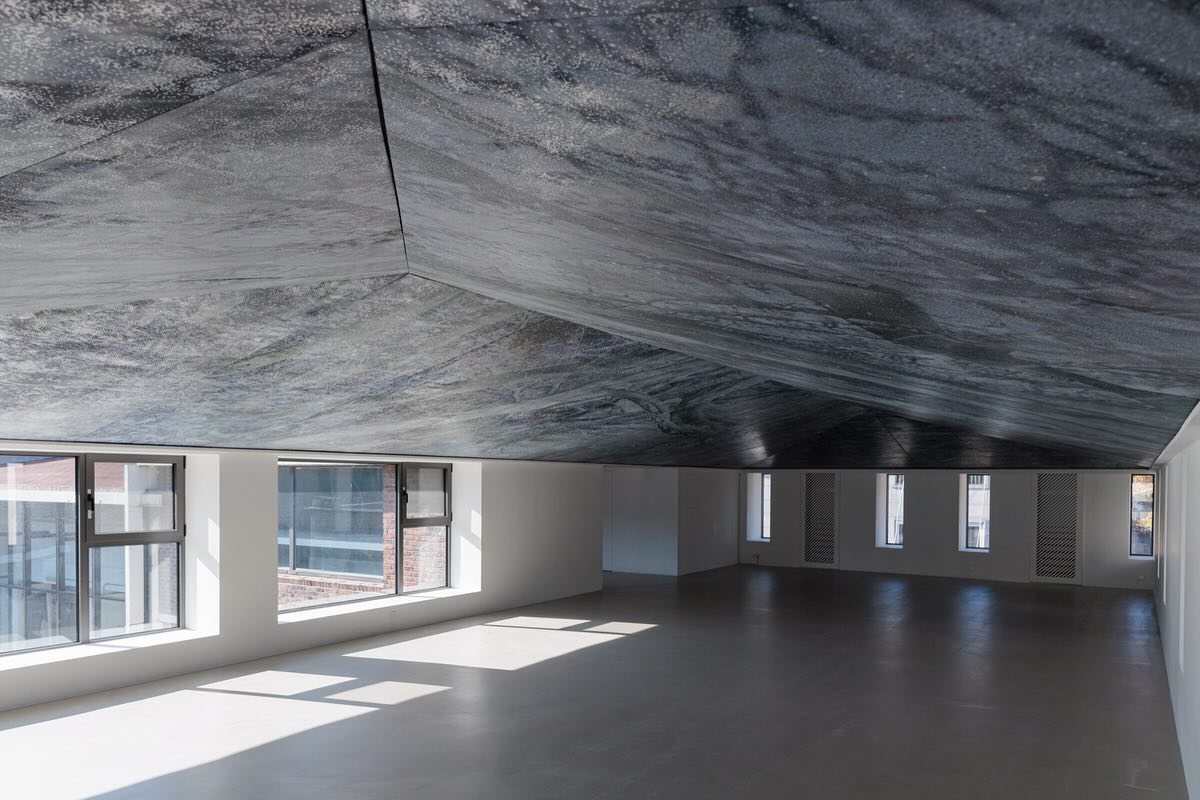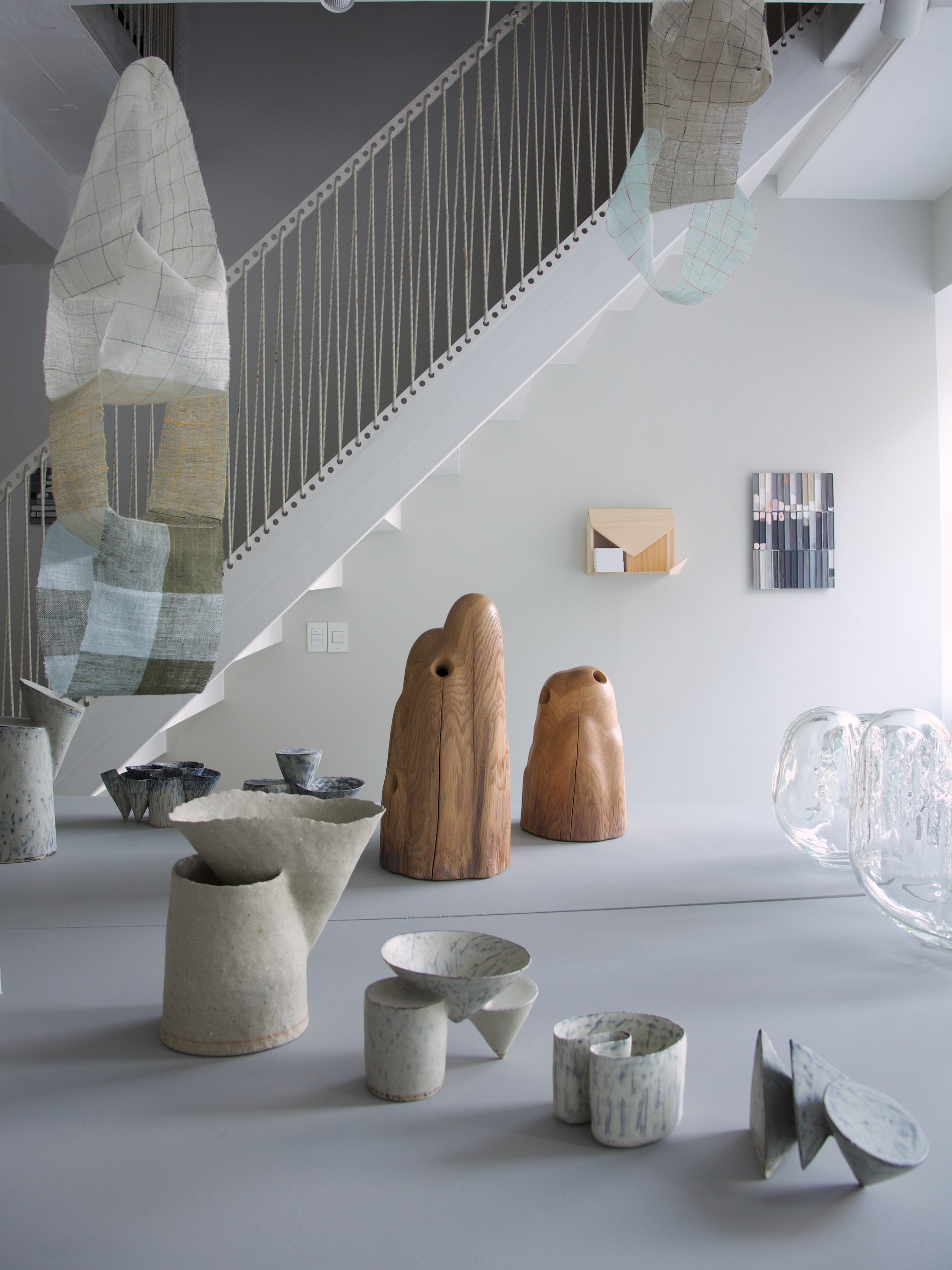Donghyun Son has explored the subject matter of his works in mass culture he enjoyed and experienced, and presented a variety of figure paintings employing techniques from East Asian ink-wash painting. Diverse characters from mass culture are adopted in his works including the Villain series featuring heroes like Superman, Batman, and villains from the James Bond 007 series and the Portrait of the King series portraying Michael Jackson, one of the most prominent mass cultural figures.
In addition to this, he has constantly interpreted logos of many brands in Munjado (文字圖, Chinese character painting). His Island is a newly interpreted rendition of the scenes of New York portrayed in films on folding screens and the HyperSpace series is a depiction of spaceships on fans. The motifs he has frequently addressed are mostly nonexistent imaginatively created beings or symbols of mass culture with some specific meaning.
After 2014, Son went further and began painting portraits of new heroes he had created. This was work reinterpreting various meanings in figure painting through the Six Principles of Chinese Painting asserted by Xie He. He makes use of traditional Korean brush techniques like brush strokes made as if they were cut with an ax, brush strokes that move down to create the effect of a loose hemp fiber, brush strokes that resemble the stems of a lotus leaf, the coloring technique of brushing on the backside of paper or cloth, rubbing techniques, and forms of graffiti and cartoon.
He has never painted landscapes in earnest in his career. Thus, the eight-fold folding screen landscape painting titled Early Spring on display at this exhibition will serve as an opportunity to newly realize his art world.

Exhibition view 'Early Spring'
Early Spring, the title of both this exhibition and his artwork is a landscape painting that dismantles Guo Xi’s Early Spring and recreates it in his own distinctive way. Guo Xi’s Early Spring demonstrates his innovative techniques for producing multiple perspectives that are called high distant (高遠), deep distance (深遠), and level distance (平遠), the basics of landscape painting. This painting displays the beauty of space typical to East Asian paintings through a partition of space with multiple perspectives unlike the single perspective normally adopted in Western paintings. This painting by Guo Xi has been a superb motif for Son to generate a new sense of space by dividing it using his own point of view.
In a sense, the space composition of a traditional landscape painting is also bound up with the idea of woyou (臥遊, aimlessly wandering while lying down) that means sensing a landscape or a space when appreciating while lying down at home. Like this, East Asian ink-wash landscape paintings are not a depiction of a real landscape but are more a notion of space. All the same, what Son is interested in is not to reach some state of cultivating and disciplining his mind while seeking something abstract but to associate mutually different things with each other untrammeled by any law.
Accordingly, Son’s Early Spring roughly depicts some part of Guo Xi’s Early Spring, but it does not clearly show which part it captures and there is no need to intentionally find this out. This article will also give an overview of his process and flow instead of analyzing each piece.
 Early Spring, 2020~2021, Ink on paper, Ink, Acrylic ink, 194×1300cm (10pieces), (Detail view)
Early Spring, 2020~2021, Ink on paper, Ink, Acrylic ink, 194×1300cm (10pieces), (Detail view)Son’s Early Spring actually does not aim to reinterpret a masterpiece from the bygone days. He has chosen Guo Xi’s Early Spring as the source of the elemental form of his landscapes. Even so, what does his use of the title Early Spring both for his artwork and exhibition mean? Early spring refers not to something being completely at its zenith but to an immature space-time almost close to a starting point.
And yet, condensed in plum blossoms blooming before sprouts or leaves appear, this point of time has us sense that it will soon be replete with the vitality of life. That being so, Son’s new work tries to encapsulate invisible senses filled with vitality that emerges at an immature stage. And, flexibility in choosing materials and techniques is required to attain this and it is determined by how free he is in his expression.
One of the most significant changes in his new work is that he initially drew sketches as if doing figure paintings and had to depend on a plan but gradually showed improvisatory composition and representation as his work progressed. Of course, he is well aware that any freewheeling style in painting cannot be brought about without the fundamental frame of form and material.
Thus, he would not disregard the importance of properties of materials and skills in using tools as well as styles in landscapes. His Early Spring completed in this way interestingly demonstrates a combination of different materials and techniques such as spraying, rubbing, back painting, diverse inks, graffiti, and cartoon rarely using brush techniques generally intrinsic to traditional landscapes.

Early Spring, 2020~2021, Ink on paper, Ink, Acrylic ink, 194×1300cm (10pieces), (Detail view)
As mentioned above, his figure paintings were particularly marked by the integration of traditional techniques into modern subject matter. After that, however, he related the heroes he had created to ideograms like Chinese characters and their signifying images and represented them based on East Asian ink-wash painting techniques and materials.
His Early Spring is not simply the fusion of elements with clarified boundaries like traditional materials and modern subject matter as well as mass culture like cartoon and fine art, but an especially distinctive melding of these elements. He is trying to diversely take many ways he considers appropriative and use them as flexibly as he can.
Thus, his landscapes vary in form, naturally forging his own pictorial idioms while departing from the styles and methods he has so far pursued. For this reason, his new work Early Spring seems not so strange to those who know his work, save for some figure in this painting.
This is because he naturally melds into the sensation not so different from his previous pieces while employing ways that are different from those he has thus far chosen. Thus, what he unmasks in this landscape is a pictorial action to strenuously embody and internalize everything he has gained on the path of painting and to quite freely express them in his new work.

Early Spring, 2020~2021, Ink on paper, Ink, Acrylic ink, 194×1300cm (10pieces), (Detail view)
If so, why does he show this attitude? His early figure paintings were anchored in observing the surface of an object rather than penetrating into its interior based on his experience with the surroundings. From then on, however, he gradually moved to his interest in an invisible stream and meaning like spirit resonance or vitality, constantly portraying his own heroes. It is really difficult to perceive some invisibly formless objects obviously and objectively. Thus, he initially tried to clearly make a link between text and image, but after that time intended to represent a blurred boundary between them by staking each meaning and surface in layers.
As this aspect is advanced in this landscape, its images collide with inner meanings in its text and are dispersed. In this way, he brings form to a landscape, emphatically stressing the flow on the surface in a variety of techniques. This work rests heavily on the senses naturally gained from things he has paid attention to in his life, instead of focusing primarily on any specific object. The combination, form, and flow of seemingly fragmentary objects in his landscapes, such as trees, mountains, the sky, paths, clouds, buildings, and text are the result of embodiment and internalization he has naturally gained through his constant working process.
Different senses including his visual experience interact with one another in his work, displaying a fluid movement. As we know, however, it is hard to accurately represent how space-time of the present comes close to us. This keeps just abstractly going round in our heads.
Therefore, he represents this as a space filled with close, expanded dynamic streams, not a far-way dim landscape. Son’s work is a sensuous landscape in which he diversely perceives and amasses the space-time we currently inhabit. Of course, he uses traditional materials and techniques to represent this but goes further, not staying there. He has consistently explored something innovative, such as embracing new materials, spraying, rubbing, and using tools most unfamiliar to him. That’s why this is a suitable way to capture some intricate, subtle point where the past he faced is mixed with the present, the boundary between imagination and reality becomes blurred, and reality is converted into unreality.
Accordingly, his Early Spring captures some concrete image but is abstract. We have always thought his wok is to search for some answer and show the result. His work seems to be a question he probably constantly asks himself. This approximates an attitude to produce a masterpiece with which he himself is satisfied, rather than being appreciated by others.
Therefore, the landscape on show at this exhibition is like enjoying a game alone, as to how to relate, remerge, and represent conflicting things such as the visible and invisible through subject matter and method he prefers and feels familiar.

이른 봄, 2020~2021, 종이에 먹, 잉크, 아크릴릭 잉크, 194×1300cm (10폭) (상세이미지)
To conclude, we need to reconsider how we are interpreting Son’s work through his Early Spring. How familiar to East Asian ink-wash painting theory and technique are we? We may already lack traditional senses. Therefore, accounts of the technique he employs, the theory critics mention, and the symbolic meaning of the objects he portrays are required. These are of course snippets of information needed to grasp his work but in a sense they at times become an obstacle to understand what is superficially showcased.
How can the landscape in which we presently inhabit be explained and depicted? This can be a description of any concrete form but sometimes appears abstract. And, this is inexplicable and cannot be defined while it is replaced with some image. In this way, the artist tries to bring different spaces and times as well as figuration and abstraction together as closely as possible. Thus, his Early Spring shows a fluid space engendered by temporarily joining different spaces and times, not one single space and time.
This has to be perceived by the senses of those who live presently, not at the stage where they understand it with their knowledge. He more freely and loosely works for this piece than in any other paintings, placing subject matter, material, technique, the past and present, imagination, and reality on the same layer. In addition to this, he is faithful to the most basic desire he can pursue, unmasking his preference.
If so, were his previous exhibitions in which he showcased various expressive methods perhaps the process of creating sensuous codes with which viewers can read his work? A variety of codes he has made can have us naturally feel his work is familiar by resolving deficiency and revealing the not yet arrived because he made this journey in the past.
As a result, we may be able to feel his landscapes as something replete when intuitively seeing colors, lines, images, and flows in his paintings rather than grasping his work through any specific information. Consequently, this exhibition is a starting point for looking at his work anew, an early spring indeed.












